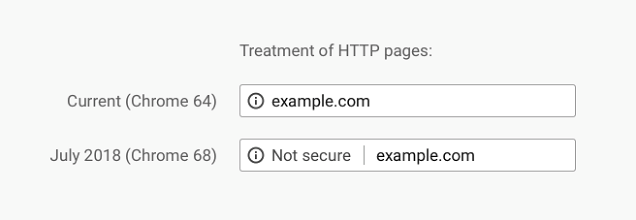You have until July to Install SSL or Google will mark your site “Not Secure”
Chrome 68, due out in July, will warn users about HTTP sites.
The time has come for all websites to migrate to HTTPS. You have until July when Chrome 68 releases.
If you’re a regular reader you know that we’ve been talking about this for a while. Google has also pushed the date back a couple of times trying to avoid the massive disruption that will occur when websites start getting labeled, “Not Secure.”
If you haven’t been following, here’s what you need to know:
Google and the rest of the browsers have been working on this for a long time. Last year Google and Mozilla began the push towards universal encryption by changing the UI on their browsers. In addition to the padlock icon, any website with SSL is marked “Secure.”
The idea was that website owners would gradually adopt SSL as more and more features were being taken away.
The browsers also began marking HTTP sites “Not Secure.” This was done more gradually. The warnings started out just warning users when they were about to enter a password in an unencrypted field. Then in the Fall they turned up the volume even more and started marking any HTTP page with text fields “Not Secure.” Now, with the release of Chrome 68 in July, Google is cranking it up to 11. Any website served via HTTP is going to get the “Not Secure” indicator.

What’s the Big Deal with HTTPS?
HTTP is ancient by computer standards. It’s a protocol for communication and it worked fine for a while. Unfortunately, HTTP is not secure. When you make an HTTP connection with a website that connection is not secure. That means that anyone can eavesdrop on the connection and steal or manipulate any data passed back-and-forth.
HTTPS is secure. When you make a connection with a website the data being sent is encrypted. That essentially makes it worthless to anyone without the corresponding key. Beyond security, HTTPS also blocks ISPs from injecting ads on your website, it is faster and performs better than HTTP and, finally, you have to have encryption in order to use HTTP/2, which is becoming more widely adopted by the day.
What do I need to do?
You need to install an SSL certificate and migrate your website to HTTPS. Before you order one though, take stock of what you need to secure. You may just have a single domain or you may have something more complicated like sub-domains or even multiple domains, in which case you’ll want to find the right certificate. Don’t worry, there’s a diverse set of offerings that cover just about every use case.
Next you’ll need to migrate to HTTPS, you can do this by changing the protocol in your URLs to HTTPS, then using 301 redirects. You may also want to take the time to add your website to HSTS preload list.
Either way, the key takeaway is that you have until July to get an SSL certificate, lest you anger Google.
And trust me, no one wants to cross Google.






































![A Look at 30 Key Cyber Crime Statistics [2023 Data Update]](https://www.thesslstore.com/blog/wp-content/uploads/2022/02/cyber-crime-statistics-feature2-75x94.jpg)













5 Ways to Determine if a Website is Fake, Fraudulent, or a Scam – 2018
in Hashing Out Cyber SecurityHow to Fix ‘ERR_SSL_PROTOCOL_ERROR’ on Google Chrome
in Everything EncryptionRe-Hashed: How to Fix SSL Connection Errors on Android Phones
in Everything EncryptionCloud Security: 5 Serious Emerging Cloud Computing Threats to Avoid
in ssl certificatesThis is what happens when your SSL certificate expires
in Everything EncryptionRe-Hashed: Troubleshoot Firefox’s “Performing TLS Handshake” Message
in Hashing Out Cyber SecurityReport it Right: AMCA got hacked – Not Quest and LabCorp
in Hashing Out Cyber SecurityRe-Hashed: How to clear HSTS settings in Chrome and Firefox
in Everything EncryptionRe-Hashed: The Difference Between SHA-1, SHA-2 and SHA-256 Hash Algorithms
in Everything EncryptionThe Difference Between Root Certificates and Intermediate Certificates
in Everything EncryptionThe difference between Encryption, Hashing and Salting
in Everything EncryptionRe-Hashed: How To Disable Firefox Insecure Password Warnings
in Hashing Out Cyber SecurityCipher Suites: Ciphers, Algorithms and Negotiating Security Settings
in Everything EncryptionThe Ultimate Hacker Movies List for December 2020
in Hashing Out Cyber Security Monthly DigestAnatomy of a Scam: Work from home for Amazon
in Hashing Out Cyber SecurityThe Top 9 Cyber Security Threats That Will Ruin Your Day
in Hashing Out Cyber SecurityHow strong is 256-bit Encryption?
in Everything EncryptionRe-Hashed: How to Trust Manually Installed Root Certificates in iOS 10.3
in Everything EncryptionHow to View SSL Certificate Details in Chrome 56
in Industry LowdownPayPal Phishing Certificates Far More Prevalent Than Previously Thought
in Industry Lowdown